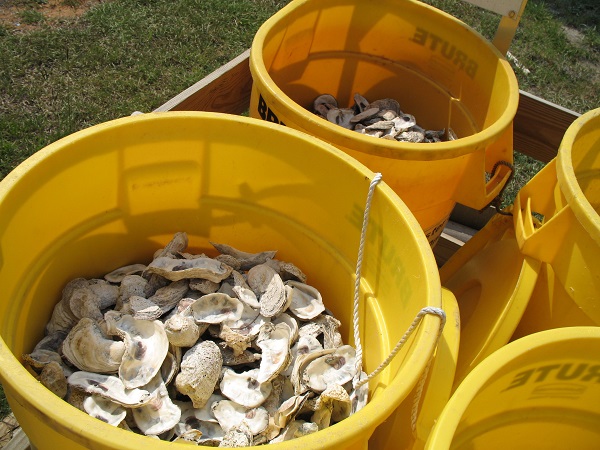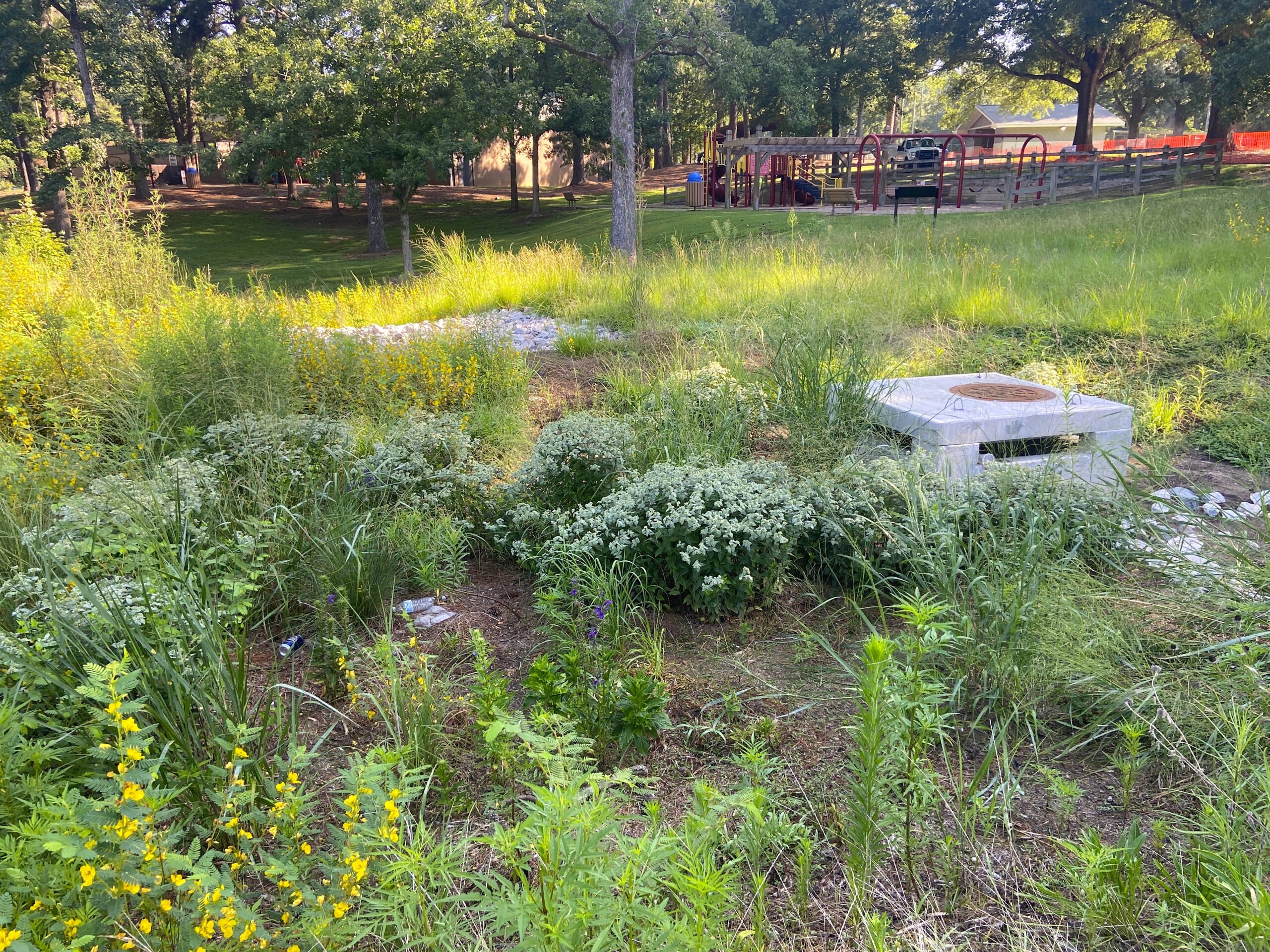A typical summer evening at a Carteret County seafood restaurant is filled with the voices of servers and customers, the clinks and clanks of silverware and the distinctive smell of freshly cooked seafood
But for Brian Woodad, the latter aroma is fleeting — the next morning, he will likely be outside these restaurants, hoisting garbage cans full of foul smelling, leftover oyster shells into the back of a pickup truck.
“It’s probably one of the worst smells I’ve ever dealt with,” admits Woodard, a Careret County Community College (CCC) student.
But it is all for a good cause.
Woodard is part of an N.C. Fishery Resource Grant (FRG) project designed to collect discarded oyster shells from the county’s restaurants and “recycle” them for use in the state’s nine oyster sanctuaries. The old shells are prime substrate for growing young Eastern oysters (Crassostrea virginica), an ecologically important species that has been in decline in North Carolina for more than a century.
The project is designed to bolster the state’s existing oyster shell recycling progam, run by the N.C. Division of Marine Fisheries (DMF), which relies on people voluntarily bringing their old oyster shells to designated drop-off sites. Collectively, restaurants are a major source of discarded shells, but organizing individual pick-ups is too costly and time consuming for DMF.
“We can handle large amounts of shells,” says Craig Hardy, a DMF section chief who heads the N.C. Oyster Shell Recycling Program, explaining the drop-off sites. “But it’s difficult for us to be spread around the state collecting five bushels here or 10 bushels there.”
Response to CCC’s recycling project is positive. Six restaurants participate, and throughout the year Woodard collects their discarded shells each week, or three to four times per week during the summer.
“Environmentally, it’s the right thing to do,” says Gene Heath, owner of the Flying Bridge restaurant in Swansboro.
Heath estimates his restaurant produces about 30 bushels of oyster shells per week in the summer — too many for him to transport to a drop-off site during peak tourist season. Instead, he and his staff separate out the shells, place them in specially designated garbage cans provided by CCC, and wait for Woodard to pick them up.
Eventually, the community college hopes to turn over the restaurant pick-up route to environmentally minded volunteers such as student or senior citizen groups.
“That’s how the project has to evolve to maintain itself,” says Philip “Skip” Kemp, project organizer and aquaculture program coordinator at CCC. “Part of what this project does is educate people about the importance of putting the shells back into the environment rather than into the driveway or the dump.”
RAISING A ROBUST RESOURCE
Oysters are vital to maintaining healthy marine ecosystems. A single oyster can filter up to 50 gallons of water a day, cleansing the water column of excess plankton and detritus. Oyster reefs also provide habitat for a multitude of organisms, including algae, worms, barnacles, crabs and fish.
A prosperous fishery in North Carolina during the late 19th and early 20th centuries, Eastern oyster populations have since been pummeled by overharvest, habitat loss, water pollution and disease. Today, oysters are listed as a “species of concern” by the DMF, and commercial landings in 2004 totaled about 69,500 bushels, a fraction of the record 1.8 million bushels landed in 1902.
“Most of the oysters being served in North Carolina are from out of state,” Heath points out.
In 2001, the N.C. Marine Fisheries Commission adopted a fishery management plan designed to help restore the state’s Eastern oyster populations. DMF began establishing no-take oyster sanctuaries throughout the Pamlico Sound, and in 2003 the N.C. Oyster Shell Recycling Program was born.
Besides helping DMF better acquire shell material for sanctuaries, aquaculture researchers at CCC saw another opportunity to help with oyster restoration efforts: provide state sanctuaries with “seeded” oyster shells, or shells with juvenile oysters already attached.
CCC researchers plan to select large oysters from the wild and breed them in aquaculture facilities, hoping the offspring will have better disease resistance.
“If you find large oysters [in nature], you assume they’ve been challenged by disease,” Kemp says. CCC’s hatchery already has several six-inch oysters from Stump Sound they plan to breed.
“Hopefully, those oysters will incorporate those robust genes back into the gene pool,” explains Hardy.
But there are no guarantees, says Don Meritt, a Maryland Sea Grant aquaculture specialist who runs the oyster hatchery program at the University of Maryland’s Center for Environmental Sciences.
“‘Resistance’ does not mean immunity to disease,” he explains. “As a population, they will live longer, but even those oysters will eventually succumb to disease.”
Breeding oysters for disease resistance originally was developed in aquaculture circles to help oysters in hatcheries reach market size and be sold, he explains. Such efforts usually involved gathering wild oysters and exposing them to disease. Those that survived had greater resistance, and were bred again.
Researchers at the CCC hatchery will not conduct such a selection program among its wild oysters. Instead, they hope nature already has taken care of that. Regardless of how the disease-resistant oysters are selected, their offspring are hardly a panacea for the ailing species.
“The question of whether you can take these superior genetic features and infuse them into wild populations remains to be seen,” says Meritt.
Some small-scale experiments in Virginia have shown that disease-resistant oysters placed in the wild have propagated, but it is extremely difficult to determine their effects on surrounding populations, says Stan Allen, director of the Aquaculture Genetics and Breeding Technology Center at the Virginia Institute of Marine Science (VIMS).
Allen describes using disease-resistant oysters in restoration as “almost like an act of desperation.” He fears that losses from overharvesting and habitat degradation already may be too great for the species to overcome.
Kemp concurs. “Disease isn’t nearly as big of a problem as the overharvesting of oysters. Overharvest and mismanagement caused the oysters to go away — when you take away oysters, you take away shell for future crops.”
A more sustainable option, he suggests, involves using aquaculture to produce oysters for seafood markets. Shell recycling and restoration efforts should be focused on no-take sanctuaries rather than areas for commercial harvest, he adds.
FIRST STEPS
In North Carolina, Kemp’s vision for such restoration efforts seems to be materializing, thanks to project participants like Heath and Woodard.
Woodard’s regular route takes about two hours. He starts in Morehead City and works his way toward Swansboro.
The pay and the schedule aren’t bad, he says. And he’s used to the smell. But as with any job, Woodard has a couple of pet peeves: restaurants that put shells in non-designated cans or mix shells with trash in the recycling cans.
“We just want the oyster shells and the oyster shells only,” he says.
Besides the obvious stench, trash becomes a nuisance when it comes time for Woodard to empty the truck.
Back on campus, Woodard dumps the new recyclables at the far end of an enormous pile of shells behind the aquaculture building. He picks out any visible trash and reloads the empty cans onto the truck.
The shell pile serves an important purpose in the recycling process, explains Kemp. Before they can be seeded in the lab, shells must sit for a year so any leftover meat or muscle can decompose.
“If there is too much organic material, it makes the water foul, so the oyster larvae don’t do well,” he says, referring to the setting tanks used to seed the shells.
At the back of the pile are the oldest oysters, which are about ready for seeding. Soon, Kemp and his students will load these shells into crates and stack them in setting tanks.
“After the shells are put into the setting tanks, then we will put the eyed-larvae oysters — which we will be growing in the hatchery — into the water,” says Kemp. “Then they swim around and attach to the shells, and they are ready to go back into the environment.”
The newly seeded shells will be planted in two new DMF sanctuaries: one along the south shore of the Neuse River, near its mouth, and the other southeast of Swan Quarter Bay, says Hardy. The seeded oyster shells will be placed on top of large, individual mounds of limestone, known as “rip-rap.”
These mounds help jump start the physical formation of the constructed reef. Under natural conditions, reefs form when oysters settle on top of each other and old shell. But oyster shells are a limited resource, says Hardy, and the rip-rap maximizes that resource by providing the constructed reef much needed elevation. Studies have shown that oysters higher in the water column survive and grow better because they are above the low-oxygen water mass.
FUTURE EFFORTS
Funding for CCC’s shell collection project will last through March 2006. Afterward, Kemp and Hardy hope to turn the effort over to volunteer groups.
“Carteret County has shown that a few people can adopt a restaurant, collect oyster shells and make them available for recycling,” says Hardy.
He hopes the DMF will add an oyster shell recycling position to help coordinate future volunteers. Funding is scarce, but a bill proposed in the N.C. General Assembly this year would provide state support for such a position.
Hardy and Kemp believe the restaurant project and the state’s shell recycling program are helping people view oyster shells as a resource for habitat restoration.
“The oyster needs oyster shell to start its life,” says Kemp. “Even the legislature has picked up on the idea and introduced a bill to ban oyster shells from landfills,” he adds.
But even if shells are kept out of landfills, set with disease-resistant juvenile oysters and placed in sanctuaries, the Eastern oyster’s plight is far from over. To truly restore habitat, the juveniles must not only survive but also reproduce and spread their offspring to adjacent reefs.
The DMF plans to monitor the sanctuaries planted with recycled, seeded shell by sampling for oyster growth, survival and structural stability, says Hardy. To monitor enhancement, DMF will sample and compare rip-rap mounds containing either seeded shells or regular shells. Hardy also hopes to engage other researchers from around the state.
“These sanctuaries and enhancement efforts provide great opportunities for oyster research in North Carolina that hopefully researchers will take advantage of,” he says.
In the meantime, Hardy, Kemp and Woodard continue to promote citizen awareness about oyster shell recycling and the restaurant project.
Woodard cites himself as an example of how even the slightest shift in perspective — and thus practice — can make a difference: “I’ve never been much for recycling, but now I feel like I am doing my part.”
This article was published in the Autumn 2005 issue of Coastwatch.
For contact information and reprint requests, visit ncseagrant.ncsu.edu/coastwatch/contact/.



